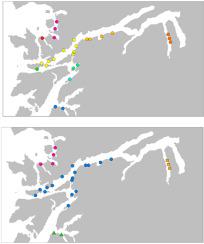Ocean & Coastal Management ( IF 4.8 ) Pub Date : 2021-08-19 , DOI: 10.1016/j.ocecoaman.2021.105849 H.A. Urke 1, 2 , K. Daae 2, 3 , H. Viljugrein 4 , I. Kandal 5 , A. Staalstrøm 2 , P.A. Jansen 1, 4

|
Aquaculture has grown to become an important export industry in Norway. The Norwegian Food Safety Authorithy (NFSA) is responsible for the management of the production zones designated to aquaculture. Fish diseases and fish parasites are among the main threats to the aquaculture industry. It is therefore of great interest to minimize the risk of fish disease agent transmission. To date, the NFSA has assigned specific subzone divisions for aquaculture installations without assessing the effects of water contact for larger areas. Transmission of infection by water contact is believed to predominate the dispersal of important fish pathogens such as salmon pancreas disease virus (SPDV), infectious salmon anaemia (ISA) virus, Aeromonas salmonicida bacterias (held efficiently under control now by effective vaccines and not a major problem), and salmon lice.
In this article we present a three-dimensional hydrodynamic model system (AquaStrøm) which gives detailed information about a network of 48 fish farm sites with varying degrees of mutual water contact in a Norwegian fjord area (the Nordfjord). By adding information on winds and currents, a better understanding of the mechanisms for the risk of transmission of fish disease agent between fish farms is gained. The risk of infection can be assessed in much more detail, and the production zones can be designed and optimized based on the level of water contact between various clusters of fish farms. Key sites which connect clusters of fish farms and hence increase the areas of mutual water contact can be identified.
中文翻译:

通过整合水动力模型改进水产养殖管理实践
水产养殖业已发展成为挪威重要的出口产业。挪威食品安全局 (NFSA) 负责管理指定用于水产养殖的生产区。鱼病和鱼寄生虫是水产养殖业面临的主要威胁。因此,最大限度地减少鱼病病原体传播的风险具有重要意义。迄今为止,NFSA 已经为水产养殖设施指定了特定的分区,而没有评估较大区域与水接触的影响。据信,通过水接触传播的感染主要是重要的鱼类病原体的传播,如鲑鱼胰腺病病毒 (SPDV)、传染性鲑鱼贫血 (ISA) 病毒、杀鲑气单胞菌 细菌(现在通过有效的疫苗得到有效控制,而不是一个主要问题)和鲑鱼虱子。
在本文中,我们展示了一个三维流体动力学模型系统 (AquaStrøm),它提供了有关挪威峡湾地区(Nordfjord)中 48 个具有不同程度相互水接触的养鱼场网络的详细信息。通过添加有关风和流的信息,可以更好地了解鱼场之间鱼病病原体传播风险的机制。可以更详细地评估感染风险,并且可以根据不同养鱼场集群之间的水接触水平来设计和优化生产区。可以确定连接鱼场集群并因此增加相互水接触区域的关键地点。











































 京公网安备 11010802027423号
京公网安备 11010802027423号